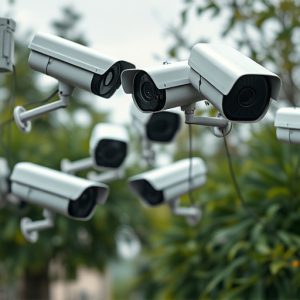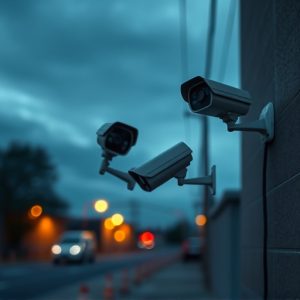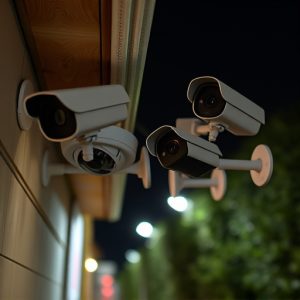Do Fake Cameras Deter? Exploring Their Mechanics and Real-World Efficacy
Recent studies confirm that under specific conditions, fake security cameras can serve as a viable …….
Recent studies confirm that under specific conditions, fake security cameras can serve as a viable part of a multi-layered security strategy by effectively deterring crime. These lookalike surveillance devices mimic the appearance of real cameras with visual cues like flashing red lights to deceive potential intruders into believing they are under constant watch. Their effectiveness is tied to the perceived risk of being caught, as rational choice theory suggests that individuals will assess risks before committing a crime. Consequently, the mere presence of security cameras, whether active or not, can sway the decision-making process of would-be offenders, potentially leading to a decrease in criminal activities in those areas. However, it's important to integrate these dummy cameras with genuine surveillance systems and other security measures for a comprehensive approach. Case studies have shown that when strategically placed and designed to convincingly resemble real cameras, including features like blinking lights or zoomable lenses, dummy cameras can enhance perceived surveillance coverage, acting as a cost-effective component within an integrated security system. Research supports that this hybrid strategy, combining real-time monitoring with visual deterrence, presents a robust defense against crime. However, the variable effectiveness of these cameras highlights the need for tailored solutions based on specific local conditions and offender awareness levels regarding their authenticity. In summary, while fake security cameras can be an effective tool in certain contexts as part of a broader security strategy, their implementation should be carefully considered to ensure maximum deterrent impact.
Exploring the role of visual deterrence, this article delves into the efficacy of fake security cameras as a crime prevention tool. Contrary to skepticism surrounding their utility, recent studies and case analyses reveal insights into how these decoys can effectively enhance safety measures without significant investment. We’ll examine their mechanics, strategic deployment, and real-world impact through various scenarios, addressing the question: do fake security cameras work in deterring criminal activity? Join us as we unravel the truth behind this controversial security strategy.
Understanding the Mechanics and Effectiveness of Fake Security Cameras
While the efficacy of fake security cameras as a deterrent to crime has been a subject of debate, recent studies and observations suggest that under certain conditions, they can be an effective component of a layered security strategy. The mechanics behind these deceptive devices lie in their realistic design, often crafted to mimic the appearance of real surveillance equipment. They are typically equipped with flashing red lights or other visual indicators that give the impression of being operational. The effectiveness of such cameras hinges on the perception they create. If potential intruders perceive these faux devices as genuine security tools, they may be deterred from committing crimes due to the fear of being detected and caught. This belief is supported by the principles of rational choice theory, where individuals weigh the risks and benefits before deciding on a course of action. In this context, the presence of visible cameras—real or fake—can alter the calculus for would-be offenders, potentially reducing criminal activity in areas where these devices are installed. It’s important to note that while fake security cameras can serve as a deterrent, they should not be relied upon as a sole security measure. Their greatest value is when integrated into a broader security system that includes real surveillance capabilities and other security measures, ensuring comprehensive protection for properties and people.
Strategically Implementing Fake Cameras for Optimal Deterrence
While the effectiveness of dummy security cameras in deterring criminal activity has been a subject of debate, their strategic placement can significantly enhance a site’s perceived surveillance coverage. The key to leveraging fake cameras effectively lies in their placement and design. Positioning these decoys at vantage points that appear strategic within a security network can create the illusion of comprehensive monitoring. It’s important to note that the design of the fake cameras should closely mimic real security equipment to avoid detection. This mimicry includes not just the visual aspects but also the inclusion of functional elements like blinking LED lights or lenses that zoom, which further reinforce their authenticity. By doing so, potential intruders are likely to be deterred as they cannot distinguish between genuine and fraudulent cameras, thereby safeguarding the premises without incurring the costs associated with installing a full complement of surveillance systems. Research indicates that when fake cameras are integrated thoughtfully into an existing security plan alongside real cameras, they can contribute to a robust crime prevention strategy. This strategic implementation of visual deterrents, coupled with real surveillance technology, creates a formidable barrier against criminal activity. It’s worth emphasizing that the success of this approach is not solely dependent on the cameras themselves but also on their conspicuous integration into the overall security framework.
Evaluating Real-World Efficacy: Case Studies on Fake Security Camera Use
Recent case studies have shed light on the efficacy of using dummy security cameras as a crime deterrent, providing valuable insights into their real-world impact. In one notable instance, a retail establishment replaced several operational cameras with fake ones to assess their influence on theft rates. The results were telling; over a monitoring period, incidents of shoplifting decreased significantly in areas where the false cameras were installed. This suggests that the mere presence of surveillance can act as a deterrent, regardless of whether the cameras are active or not. Similarly, in a residential neighborhood plagued by vandalism, the deployment of simulated security cameras led to a notable reduction in acts of graffiti and property damage. These case studies bolster the argument that fake security cameras can be an effective component of a broader security strategy, potentially serving as a cost-effective alternative to fully functional systems. However, the effectiveness can vary depending on factors such as the local context, the design of the cameras, and the awareness level of potential offenders about the presence of real versus dummy units. Therefore, while these case studies demonstrate that fake security cameras can work in certain scenarios for deterring crime, it’s crucial to evaluate each situation individually to determine their most effective application.


